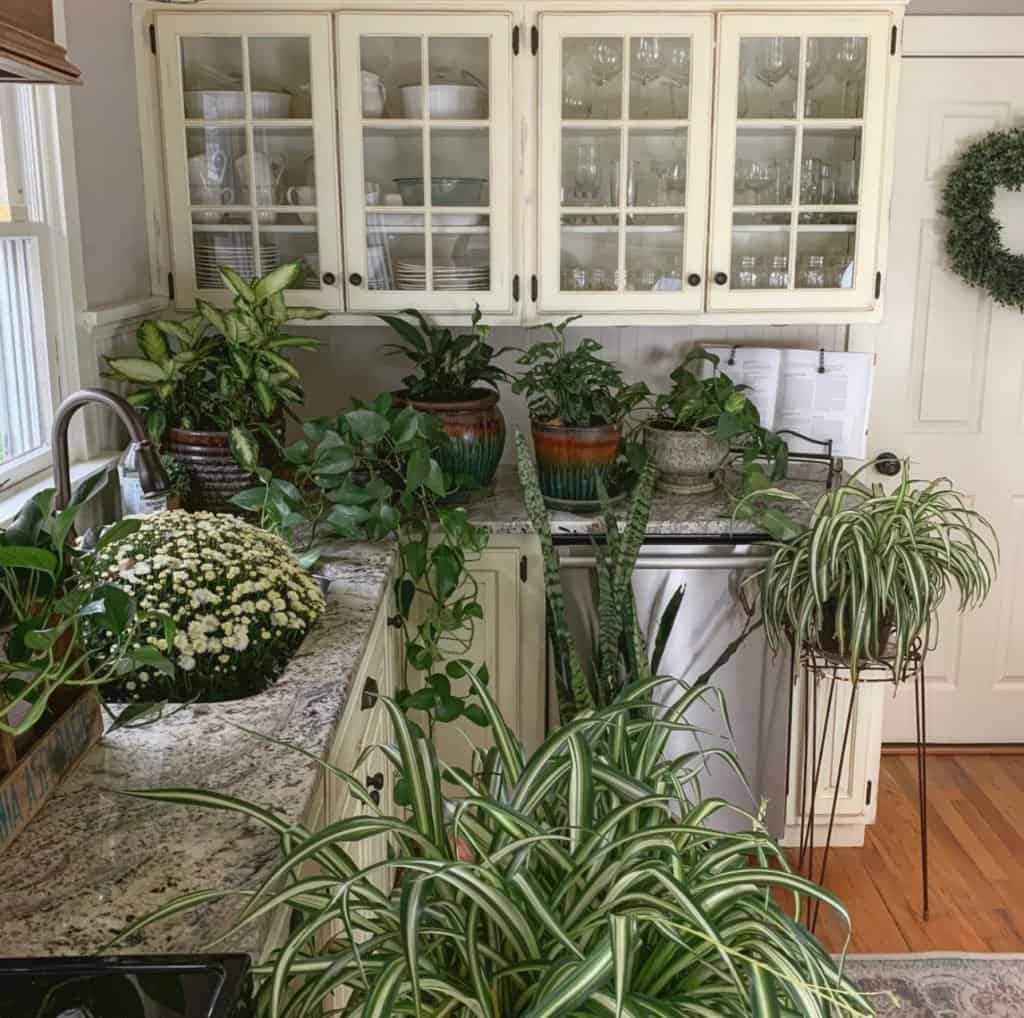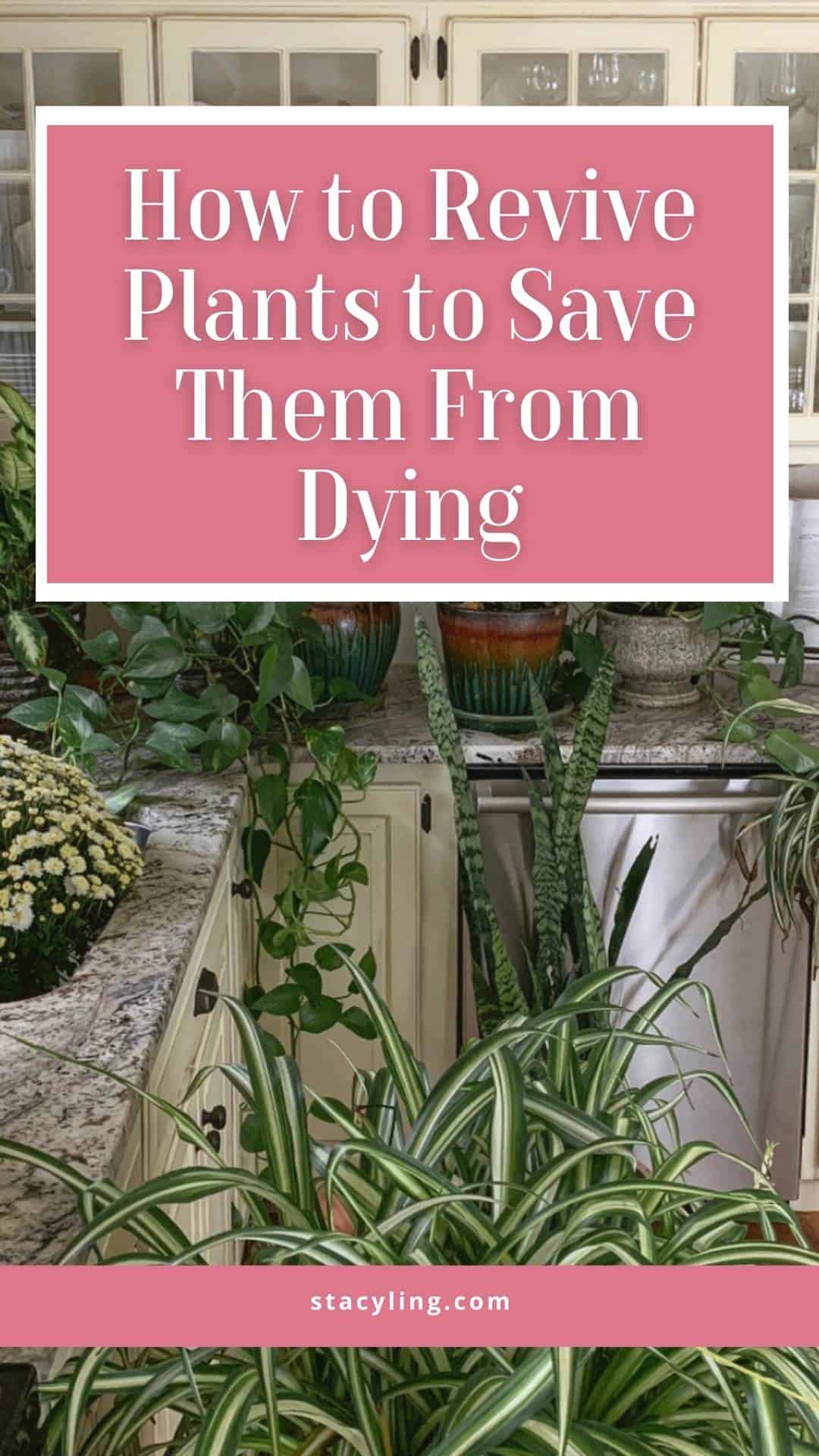Do you have a houseplant that looks wilted, sad, or otherwise in need of attention? Learn how to revive houseplants with these simple tips.
The other day, my daughter brought some plants home from my husband’s office that are in dire need of attention.
The leaves are crispy and the soil is dry on a dracaena. The foliage is partially crispy and the soil is saturated on a parlor palm plant. Although the diagnosis of what went wrong is a little different with each, the revitalization process is similar.
This post will explain how to revive dying plants and give them a new chance at life.
(Posts on stacyling.com may contain affiliate links. Click HERE for full disclosure.)
Can You Bring an Indoor Plant Back to Life?
Much like people, plants grow and need food, water, light, and air to survive.
When caring for plants, it’s important to keep in mind that not all plants are the same and can’t be treated the same.
So, Why Do Plants Decline?
Sometimes bad things happen to good plants.
Sometimes bad things happen to good plants. There are so many reasons that plants decline, including:
- They get overwatered, underwatered, or a combination of both.
- Houseplants are over-fertilized.
- They’re placed in a site that doesn’t receive the proper light.
- The indoor plants outgrew their containers.
- They’ve not been fed at all.
- The houseplant was never removed from its nursery pot (in this case, the plant probably did well for a while, then started to decline).
- They get dusty and don’t get enough photosynthesis.
No matter what has gone wrong with your house plant, don’t beat yourself up too much over it.
It happens, even to the best of us.
But all is not lost. In most cases, indoor plants can be revived with a little TLC.

How to Tell if Your Plant Is Dead or Alive
Before you start trying to revive a dying houseplant, it’s important to check for some signs of life. Sometimes a plant that looks like a lost cause can absolutely be brought back to life. Other times, a plant that looks like it’s dead may simply be dormant (like a Christmas amaryllis).
Unfortunately, there are times when a plant is too far gone to be saved. So before you start using plant-life-saving measures, be sure to examine your house plant closely. Here are some ways to tell if your plant is alive or dead.
Check the Stems
Inspect the plant stems first. Stems of living plants will be flexible and will have a green color. For plants with woody stems, scrape back a tiny bit of the bark to check for green underneath. If the stems are green (even if the leaves are drooping and it looks generally in decline), there’s a good chance you can revive the plant.

Examine the Roots
Carefully remove the indoor plant from its pot so you can look at the roots. Don’t worry – if you decide to revive the houseplant you’ll need to do this step anyway. And checking the roots is a good way to help assess plant health.
- If the roots are healthy, they should look white or yellow and slightly plump.
- If your roots are starting to brown then your plant is in trouble but it still has the potential to be brought back to life.
- If the roots show signs of root rot, however, your plant is likely beyond saving. But you never know, so I usually give it a whirl anyway. What do you have to lose?
Important Note About Winter Dormancy for Houseplants
When determining whether or not your green plants are in trouble, it’s important to keep in mind the time of year too. During colder, darker months, houseplants go into dormancy and indoor plants might not look so amazing.
For example, my Boston ferns always look amazing from spring through fall after a season outdoors when the temperatures are more warm and humid. Whenever I bring them in for winter, they will lose some leaves and brown out a little. This is normal for the plant because it’s resting. Throughout the winter, I’ll periodically cut the dead stuff off and then get it back outside again in spring where it rebounds every year thanks to longer days and more humidity in the air.
It’s important to allow plants to be dormant and not overcare for them when they are trying to rest. They may not look their best, but it’s part of their process going from fall to spring. Unless your plant is being overwatered, for example, and experiencing pests, disease, and other problems, I would recommend a less is more approach for winter houseplant care.
Pro-Tip: Avoid watering on the same day every week and check the soil for dryness before watering so you don’t stress the plant and then need to revive it! A great way to check for soil dryness is to stick your finger into the soil about an inch down or use a moisture meter.

Assessment of My Husband’s Houseplants
Looking at my husband’s office plants?
The dracaena was totally neglected. It needs water, fresh potting soil, and a new container that is slightly larger than its current size.
The opposite is the case of the parlor palm. That plant’s soil is completely saturated and appears really stressed. Looking at the size of the plant in comparison to the container and the root system, it too needs to be potted up in a larger container.
Although the diagnosis is a little different for each plant, the revitalization process of reviving a dying houseplant is the same. Here’s how we will save my husband’s office plants. Use these same tips to save any struggling houseplants in your own home.

Supplies Needed to Revive Plants
You likely already have these supplies on hand but in case you don’t, here’s a quick list of what I use when reviving houseplants.
- Pruners or Garden Snips
- Potting Soil with Perlite
- Compost
- Larger Container
- Fish Emulsion

How to Revive Houseplants
In general, follow these steps to revive dying plants.
Step 1 – Assess the Plant
Ask yourself a few questions before you begin so you hit all of the things that could impact plant health.
- Is the soil saturated or dry as a bone?
- Is any of the foliage green and healthy?
- If only stems are present, like this dracaena, scratch the stem to see if it’s green underneath. Is there any new growth that is visible?
- Do you see any bugs or signs of disease?
When you inspect the plant carefully you’ll have a better idea of what might be causing the plant to decline before you start working on it.

Step 2 – Cut Off the Dead Foliage
Take a sharp set of pruners or garden snips and cut off all of the foliage that is dry, then discard. It looks better already!
But there’s more.
Step 3 – Remove the Plant From the Container
When reviving a plant, remove the plant from its container. Then check the root system and soil.
Are the roots all bound up and wrapped around each other? If so, the plant is pot-bound, which means, the roots need to be cleaned up and the plant needs to be replanted in a larger container so the roots have room to grow.


Step 4 – Tease the Roots
After removing your plant from its container, tease the roots to encourage them to grow outward into the soil. You can also chop off the bottom part of the rootbound area with a hori hori knife so it’s easier to tease the roots out.
Root-bound plants need a little help, so don’t be shy! Scoring a few and teasing those roots encourages growth outward.
Step 5 – Change the Soil
If the soil is dry as a bone or supersaturated, remove as much of the soil as you can. Then, prepare to replant the houseplant in a larger container with new potting soil.
Step 6 – Choose a Larger Container
Before repotting the plant, select a container that is slightly larger than the one you just removed it from. Many times, plants just need more room to grow!
By going one size up with your container, the roots will have space to grow outward instead of inward amongst themselves.

Step 7 – Repot the Plant
To repot the plant and give it a fresh start, grab some new potting soil. Then replant your houseplant in its new, larger pot.
Step 8 – Feed Your Plant
If the potting mix you’re using to repot your plant doesn’t already have it, mix in a little perlite to aerate the soil. Then, give your plant some much-needed fuel by adding some worm castings or compost to help add fresh nutrients into the soil to feed the plant.

Step 9 – Watering Your Houseplants
If the plant you are reviving was waterlogged, I would give it a few days before watering it in its new home to allow the roots to dry out a little bit. Soggy roots encourage pest and disease problems and we would want them to dry out a little before trying to water them again.
If the plant you are reviving was dry as a bone from neglect, water it well but don’t waterlog it.
Note: During the winter months, plants need less water while they are in dormancy. So always check the soil before watering to see if it’s still moist. Over time, you will learn how much water each plant actually needs.

Step 10 – Place In an Area that Receives Light, But Not Direct Sunlight
Even if your plants love bright sunlight, they are rehabbing, so keep them under an awning on a porch in the shade, or near a bright window without receiving direct light while they recover.
As the plant rebounds, do some research and determine the best location for that plant in your home or office to get the optimal sun conditions for that specific plant.

Step 11 – Monitor Plants
Keep an eye on plants while reviving them. If the soil starts to dry out, water it but do not oversaturate it.
And make sure the plant dries out between waterings. So check the soil before watering like I mentioned earlier.
I know it’s easier to pick a day of the week to water plants but not all plants will need it on that particular day. Do THIS test to make sure it’s not wet near the roots. If the soil is still damp, leave it alone.

After Reviving My Husband’s Office Houseplants
The parlor palm looks pretty good. I removed most of the soggy, saturated soil and repotted it in a slightly larger container that I had on hand.
Now that it’s been repotted, it will stay outside for the rest of the summer humidity under the roofline on my deck so it gets fresh air, and light and will receive water as needed.
Although the dracaena has seen better days, it too looks a lot better. And check it out! The fresh growth doubled since I repotted it. So hopefully this plant will eventually make a recovery.
In about a week or so, I’ll feed them with some fish emulsion to help them along.

How long does it take for a wilted plant to recover?
How long it takes to revive a houseplant really depends on the type of plant and the state of the plant when you start the revival process. If your plant is primarily just drooping and wilting, it may perk back up in a number of days.
If your plant is further gone however and either very dry and brittle or very overwatered, it can take up to a month to see any significant changes or new growth.
The most important thing is to be patient and don’t give up on your plant too soon!
Thanks for joining me today in the garden!

Want to Learn More?
Watch it my latest video where I’m sharing the secret to keeping houseplants alive that will change your perspective on how and when you water.

Pin and Save It For Later

Thank you so much for following along.
Enjoy a beautiful day! xo








